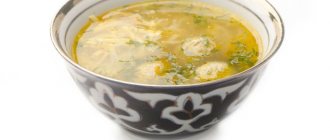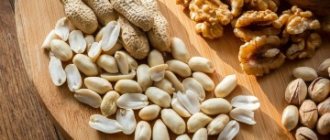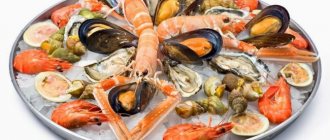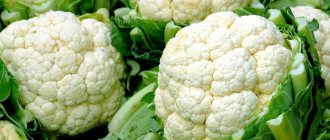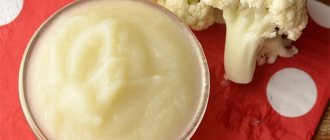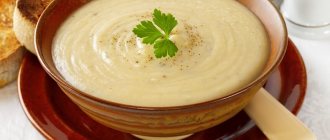Cabbage: mineral composition and calorie content
The most accessible and widespread type of cabbage is white cabbage. This vegetable is present in the recipes of first, hot courses, snacks, pies, and salads. The calorie content of the product is minimal - only 28 kcal per 100 g. The national love for the vegetable is not accidental - it contains a whole list of valuable vitamins and minerals that are easily absorbed by the body. However, other types of cabbage are also appropriate in the diet of a nursing mother; in many respects they are superior to the most common variety.
Cabbage contains the entire spectrum of vitamins and minerals necessary for healthy life.
Table: content of main components in different types
| Nutrient | White cabbage 100 g | Broccoli 100 g | Cauliflower 100 g | Brussels sprouts 100 g | Beijing cabbage 100 g |
| Calorie content | 28 kcal | 34 kcal | 30 kcal | 43 kcal | 16 kcal |
| Squirrels | 1.8 g | 2.8 g | 2.5 g | 3.38 g | 1.2 g |
| Fats | 0.2 g | 0.4 g | 0.3 g | 0.3 g | 0.2 g |
| Carbohydrates | 4.7 g | 6.6 g | 4.2 g | 8.95 g | 2.03 g |
| Alimentary fiber | 2 g | 2.6 g | 2.1 g | 3.8 g | 1.2 g |
| Water | 90.4 g | 89.3 g | 90 g | 86 g | 94.39 g |
| Vitamins | |||||
| Vitamin A, RE | 3 mcg | 386 mcg | 3 mcg | 38 mcg | 16 mcg |
| Vitamin C (ascorbic acid) | 60 mg | 89.2 mg | 70 mg | 85 mg | 27 mg |
| Vitamin K (phylloquinone) | 76 mcg | 101.6 mcg | 16 mcg | 177 mcg | 42.9 mcg |
| Vitamin RR, NE | 0.9 mg | 1.1071 mg | 1 mg | 0.745 mg | 0.5992 mg |
| Macronutrients | |||||
| Potassium, K | 300 mg | 316 mg | 210 mg | 389 mg | 238 mg |
| Calcium, Ca | 48 mg | 47 mg | 26 mg | 42 mg | 77 mg |
| Magnesium, Mg | 16 mg | 21 mg | 17 mg | 23 mg | 13 mg |
| Sodium, Na | 13 mg | 33 mg | 10 mg | 25 mg | 9 mg |
| Phosphorus, Ph | 31 mg | 66 mg | 51 mg | 69 mg | 29 mg |
| Microelements | |||||
| Iron, Fe | 0.6 mg | 0.73 mg | 1.4 mg | 1.4 mg | 0.31 mg |
| Manganese, Mn | 0.17 mg | 0.21 mg | 0.156 mg | 0.337 mg | 0.19 mg |
| Copper, Cu | 80 mcg | 49 mcg | 42 mcg | 70 mcg | 36 mcg |
| Selenium, Se | 0.3 mcg | 2.5 mcg | 0.6 mcg | 1.6 mcg | 0.6 mcg |
| Zinc, Zn | 0.4 mg | 0.41 mg | 0.28 mg | 0.42 mg | 0.23 mg |
Contraindications
Despite all its usefulness, Brussels sprouts have a number of contraindications. It is not recommended to be included in the diet for people suffering from:
- increased stomach acidity;
- enterocolitis;
- intestinal cramps;
- inflammation of the gastrointestinal tract;
- thyroid problems;
- increased content of vitamin C in the body;
- in case of individual intolerance to the components.
At an early stage, you should not include this vegetable in your child’s menu if he has:
- colic;
- bloating;
- chronic gastritis with high acidity.
Cabbage during breastfeeding
Foreign experts in the field of breastfeeding recommend sticking to the usual menu during breastfeeding, not excluding cabbage. Domestic pediatricians are wary of the vegetable, believing that it causes bloating not only in a nursing woman, but also in a baby. Nevertheless, this product is one of the richest in mineral composition and beneficial properties for the body.
Useful properties of the white cabbage variety
There is no scientific evidence that substances that cause digestive problems enter the baby’s body through mother’s milk. Perhaps this is just a stereotype that has developed due to the fact that cabbage provokes increased gas formation in the woman herself. But the vitamins and microelements contained in the vegetable partially enter the milk, enriching it and making it more nutritious.
The main advantages of white cabbage in the diet of a nursing woman:
- the vegetable contains a large amount of B vitamins. Thanks to this, cabbage helps normalize the activity of the brain and nervous system;
- cabbage occupies a leading position in the content of vitamin C. This allows you to fight viruses during cold seasons and strengthen the immune system in a natural way;
- the vegetable contains a set of microelements necessary for the full development of the child, his musculoskeletal system, central nervous and cardiovascular systems. This category includes iron, magnesium, fluorine, zinc, sulfur, chlorine, copper and other valuable microelements;
- cabbage is rich in antioxidants, which reduce the effects of negative metals on the body and help cleanse toxins;
- Cabbage leaves are used in folk medicine as compresses on the chest for lactostasis and mastitis.
Other varieties for breastfeeding
If white cabbage still causes concern or provokes flatulence or is difficult to digest, it is worth including in the diet other varieties that do not have such an effect on the gastrointestinal tract and are rich in vitamins and minerals.
The mineral composition of different types of cabbage is different, so each of them has its own positive effect on the body.
The following varieties are preferred in the diet of a nursing mother:
- broccoli. Contains easily digestible vegetable protein, not inferior in quality to proteins of animal origin. Broccoli has a general strengthening effect on the body and helps resist viruses. It has a high content of vitamin A and folic acid, and is considered one of the healthiest vegetables;
- cauliflower. It is especially valued for its positive effect on the digestive tract and has a mild laxative effect. Cauliflower improves metabolism, increases children's immunity, helps in the fight against postpartum depression and stress;
- Brussels sprouts. Rich in vitamin C, iron, phosphorus, potassium. Reduces the likelihood of blood clots forming, helps the growth of the baby’s bone and muscle tissue;
- Chinese cabbage. Contains soft fiber and is low in calories. The vegetable is consumed mainly fresh. Chinese cabbage helps with anemia and reduces the intensity of headaches. Vitamin PP contained in the product is especially valuable for the development of the child’s nervous system.
Varieties useful for nursing mothers: photo gallery
Broccoli contains vitamins C and K, which are necessary for the normal functioning of connective and bone tissue, as well as for healthy kidney function.
Many people love and appreciate cauliflower for its delicate taste and usefulness.
Brussels sprouts are among the vegetables whose consumption reduces the risk of cancer and pathologies of the cardiovascular system
Chinese cabbage brings much fewer digestive problems
Feedback from nursing mothers
Since I was two months old I have been eating borscht and cabbage soup. stew - everything is fine. But I’m still somehow afraid to eat fresh salad.
Ankhen
https://www.baby.ru/community/view/3335924/forum/post/87423716/
Yes, everything is possible, but I was on a strict diet for a month, and now I’m slowly starting to eat everything. but I’m afraid to eat cabbage right now, I only eat cauliflower
Kopilka
https://www.u-mama.ru/forum/kids/0–1/272063/index.html
I eat - nothing. I read that it is not necessary that cabbage, peas and the like will make a child swell. :)) After all, peas, for example, enter the digestive tract of the mother, not the child. A negative reaction will only occur if the mother reacts poorly to this product...
Butyavka
https://2006–2009.littleone.ru/archive/index.php/t-118278.html
Beneficial features
First you need to get acquainted with all the properties of this vegetable. Firstly, it contains a lot of vitamin C, iron, fiber, potassium and phosphorus. Secondly, the calorie content per 100 grams is only 38 calories. Carbohydrates 8 gr. Thirdly, it has an excellent effect on all systems and organs and supports the immune system.
So, can a young mother have Brussels sprouts during breastfeeding? Yes, you can.
If we talk about favorable factors affecting the body, there are a lot of them. Pros:
When breastfeeding, you can diversify your meals with this vegetable crop. However, you should not lean on it, because any food is introduced gradually.
In small quantities during breastfeeding, it is allowed only for those who do not have problems with the stomach and acidity, as well as with the thyroid gland.
If you feel pain in the intestines after eating, it means that your stomach does not absorb this culture, although this happens quite rarely. Perhaps, if pain occurs, you need to contact a gastroenterologist for an examination.
Rules of caution
Almost all types of this vegetable may have contraindications if a woman suffers from diseases of the stomach and intestines. Broccoli and cauliflower are considered the most “soft” for the digestive system. When introducing any type of cabbage into the diet of a nursing mother, you should consult a pediatrician.
When planning to introduce a vegetable into the diet during breastfeeding, it is recommended to adhere to the following rules:
- white cabbage can be introduced into the diet no earlier than the baby is 3 months old, due to the risk of increased gas formation in the child;
- broccoli and cauliflower can be eaten 2-3 weeks after birth;
- for the first time you are allowed to eat a small portion of the product - 50–100 g (before heat treatment). If there are no negative reactions from digestion or an allergic rash in the baby, the portion is increased every day by 50 g. The daily intake of ready-made white cabbage for a nursing mother is 100–150 g, cauliflower and broccoli - up to 200 g;
- It is recommended to heat treat the vegetable, since fresh cabbage contains coarse fiber, which provokes flatulence. Up to 6 months of age, it is advisable to eat cabbage in stewed, boiled, baked forms;
- it is necessary to monitor the baby’s reaction, especially in terms of digestion, even though cabbage is considered a low-allergenic product. If undesirable reactions are detected, the vegetable is excluded from the diet for several weeks;
- cabbage can be added to soups and broths to stimulate lactation. Warm, abundant drinking helps increase the volume of breast milk, and cabbage enriches it with minerals;
- It is not recommended to use sauerkraut and pickled cabbage during breastfeeding, due to the abundance of salt and spices in the composition;
- You should not overuse seaweed (although it is not a vegetable, but an algae), as it is considered highly allergenic.
Let's sum it up
Cabbage is a very healthy vegetable, be it white or red. When feeding breast milk, you should not completely abandon it. Braised cabbage (preferably cooked in water - in a slow cooker or double boiler) can be consumed by a nursing mother starting from the second month of the baby’s life, but only in moderate quantities. Fresh cabbage in the first month after birth is not recommended, since the newborn baby has not yet adapted to such food, and the body’s possible response will be negative.
Dishes for nursing mothers
White cabbage is often used to make fresh salads. Broccoli and cauliflower are not consumed raw due to the lack of distinct taste and difficulty in chewing. In the diet of a nursing mother, dishes containing stewed or boiled cabbage are appropriate: soups, stews, casseroles.
Creamy soup with cauliflower
Ingredients:
- turkey breast - 300 g;
- water - 0.5 l;
- potatoes - 2 pcs.;
- cauliflower - 300 g;
- dill and parsley to taste;
- salt and spices to taste.
You can also add butter and rye croutons to the cauliflower puree soup before serving
. Preparation:
- Boil turkey meat in boiling water for 1.5 hours.
- Peel and cut the potatoes into cubes, chop the greens.
- Chop the cauliflower florets coarsely.
- Add potatoes, cauliflower, salt and spices to the boiling broth and cook until the vegetables are ready.
- Beat the mixture with a blender until smooth.
- Sprinkle with herbs before serving.
Broccoli omelette
Ingredients:
- broccoli - 300 g;
- sour cream - 2 tbsp. l.;
- chicken eggs - 2 pcs.;
- flour - 1 tbsp. l.;
- salt and olive oil.
In addition to broccoli, you can add other vegetables to the omelette, making sure that your child is not allergic to them
. Preparation:
- Blanch broccoli in boiling water for 3-4 minutes.
- Beat eggs with sour cream, salt and flour with a mixer or whisk.
- Grease a baking dish with oil and arrange the broccoli.
- Pour the egg mixture over the vegetables and place in the oven for 15 minutes at 180 degrees.
Vegetable stew with cabbage
Ingredients:
- white cabbage - 300 g;
- potatoes - 300 g;
- zucchini - 200 g;
- onion - 1 head;
- carrots - 100 g;
- olive oil, spices to taste.
If other vegetables are already present in the diet, and the baby does not have a negative reaction, you can add bell pepper, garlic, and eggplant to the dish
. Preparation:
- In a heated saucepan with olive oil, simmer shredded cabbage until soft.
- Add grated carrots and chopped onions.
- The potatoes are peeled, cut into cubes and added to the rest of the vegetables.
- Add enough water so that it barely covers the contents, add spices and simmer until the potatoes are ready.



